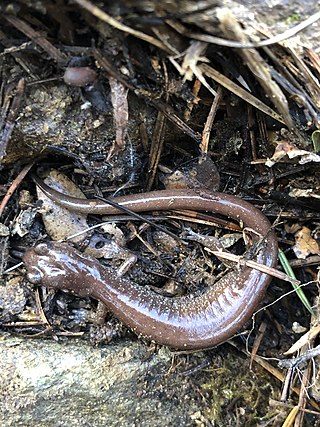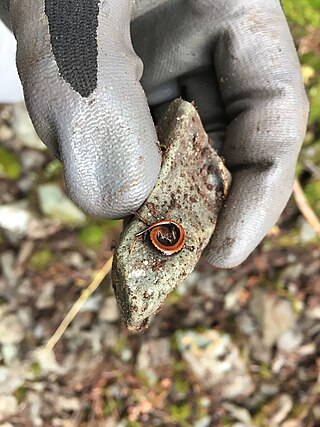
Plethodon is a genus of salamanders in the family Plethodontidae. They are commonly known as woodland salamanders. All members of the genus are endemic to North America. They have no aquatic larval stage. In some species, such as the red-backed salamander. Young hatch in the adult form. Members of Plethodon primarily eat small invertebrates. The earliest known fossils of this genus are from the Hemphillian of Tennessee in the United States.

The northern slimy salamander is a species of terrestrial plethodontid salamander found throughout much of the eastern two-thirds of the United States.
Leptopelis jordani is a species of little-known frog in the family Arthroleptidae. Common name Congulu forest treefrog has been coined for it.
Parhoplophryne is a monotypic frog genus in the family Microhylidae. The sole species is Parhoplophryne usambarica, sometimes known as the Usambara black-banded frog or Amani forest frog. It is endemic to the East Usambara Mountains in Tanzania. It is only known from one specimen collected in the 1920s and is feared to be extinct.
The cave splayfoot salamander is a species of salamander in the family Plethodontidae. It is endemic to Mexico, specifically in the Sierra Madre Oriental pine–oak forests of the northern region of Hidalgo, Mexico. The species was thought to be extinct for over 70 years since its first observation and a study of five salamanders made by Robert Livingston and Harold T. Woodall in 1937. In 2010, this species was spotted for the first time since its 1941 description by Dr. Sean Rovito who identified two individuals during his search for other lost amphibian species.

The Scott Bar salamander is a species of salamander in the family Plethodontidae, endemic to the United States, where it is restricted to a very small range in the Scott River drainage in Siskiyou County, California, at altitudes between 700 and 1,300 metres above sea level. Described in 2005, it is one of the most recently described species in the large genus Plethodon.

The Cheoah Bald salamander is a species of salamander in the family Plethodontidae endemic to the state of North Carolina in the United States. Its natural habitat is temperate forests and it is threatened by habitat loss. It was formerly considered a variant of the red-cheeked salamander until it was found to be a distinct species.

Dunn's salamander is a species of salamander in the family Plethodontidae endemic to the western United States.

The Del Norte salamander is a species of salamander in the family Plethodontidae endemic to the United States in southwestern Oregon and northwestern California.

The Valley and Ridge salamander is a species of salamander in the family Plethodontidae endemic to the Appalachian Mountains in the eastern United States.
The Coeur d'Alene salamander is a species of woodland salamander (Plethodon) in the family of lungless salamanders (Plethodontidae) found in northern Idaho, western Montana, and southeastern British Columbia. This species was discovered in 1939 by James R. Slater and John W. Slipp on the south shore of Lake Coeur d'Alene in northern Idaho. It was once considered to be a subspecies of Van Dyke's salamander, as P. vandykei idahoensis, but appears to be a distinct and separate species as originally suggested by Slater and Slipp (1940).
The Kiamichi slimy salamander is a species of salamander in the family Plethodontidae endemic to the United States, has a natural habitat of temperate forests, and is found over a small range. This nocturnal species is mainly threatened by habitat loss and was first described by Highton in 1989. It is rated as a vulnerable species by the International Union for Conservation of Nature.

The Larch Mountain salamander is a species of salamander in the family Plethodontidae endemic to the United States. It occurs in the Cascade Mountains of southern Washington and northern Oregon. In Washington, it occurs from the Columbia River Gorge to just north of Snoqualmie Pass. Its natural habitats are temperate forests and rocky areas. It is threatened by habitat loss.

The northern gray-cheeked salamander is a species of salamander in the family Plethodontidae and endemic to the Blue Ridge Mountains and Appalachian Mountains in the eastern United States. It is closely related to the Red-cheeked salamander and the Red-legged salamander. Its natural habitat is temperate forests. It is found under moss, rocks, logs, and bark in cool, moist forests above 2500 feet. Especially found in spruce-fir forests. The Gray-cheeked Salamander commonly eats millipedes, earthworms, crane flies, spiders, and centipedes and less commonly eats ants, mites, and springtails. They eat spiders, moths, flies, beetles, bees, and snails. The male and female perform a courtship, where the male nudges the female with his snout, does a foot dance, then circles under the female and the two then walk together. Like other salamanders, they do not migrate or aggregate during breeding season. It is threatened by habitat loss.

Weller's salamander is a species of salamander in the family Plethodontidae. This species in endemic to the southeastern mountain range of the United States. It is mainly found in North Carolina near Grandfather Mountain. The salamanders have a unique metallic spotting which distinguishes them from other Plethodon species and other salamanders in the area. They mainly inhabit cool forests with rocky areas.
Pseudoeurycea aquatica, which has been given the common name of aquatic salamander is a species of salamander in the family Plethodontidae. It is endemic to Mexico and only known from its type locality in the Sierra Madre de Oaxaca near Totontepec Villa de Morelos, Oaxaca.
Aquiloeurycea praecellens, also known as the admirable false brook salamander, is a species of salamander in the family Plethodontidae. It is endemic to the Sierra Madre Oriental in Veracruz, Mexico. Its natural habitat is lowland tropical moist forest where it is threatened by habitat loss.
The Blacksburg salamander is a species of salamander in the family Plethodontidae. It is endemic to the Southeastern United States, where it is restricted to a portion of the Appalachian Mountains in southwestern Virginia. Its common name refers the town of Blacksburg, Virginia, as many specimens were initially found in the vicinity of the town.











